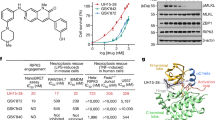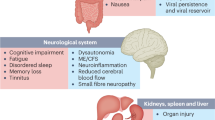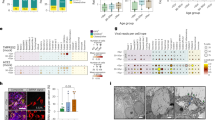Abstract
Asthma is one of the most common chronic immunological diseases in humans, affecting people from childhood to old age. Progress in treating asthma has been relatively slow and treatment guidelines have mostly recommended empirical approaches on the basis of clinical measures of disease severity rather than on the basis of the underlying mechanisms of pathogenesis. An important molecular mechanism of asthma is type 2 inflammation, which occurs in many but not all patients. In this Opinion article, I explore the role of type 2 inflammation in asthma, including lessons learnt from clinical trials of inhibitors of type 2 inflammation. I consider how dichotomizing asthma according to levels of type 2 inflammation — into 'T helper 2 (TH2)-high' and 'TH2-low' subtypes (endotypes) — has shaped our thinking about the pathobiology of asthma and has generated new interest in understanding the mechanisms of disease that are independent of type 2 inflammation.
This is a preview of subscription content, access via your institution
Access options
Subscribe to this journal
Receive 12 print issues and online access
$209.00 per year
only $17.42 per issue
Buy this article
- Purchase on Springer Link
- Instant access to full article PDF
Prices may be subject to local taxes which are calculated during checkout




Similar content being viewed by others
Change history
19 January 2015
In the version of this article that was originally published, the targeted epitope of lebrikizumab was listed as "IL‑4Rα" in Table 1 but this should be "IL‑13 (IL‑4Rα‑binding epitope)”. Also, for the main effects of lebrikizumab in human asthma trials, the citation of reference 44 should be reference 48. The author apologizes for these errors, which have now been corrected online.
References
Spellberg, B. & Edwards, J. E. Jr. Type 1/type 2 immunity in infectious diseases. Clin. Infect. Dis. 32, 76–102 (2001).
Voehringer, D., Reese, T. A., Huang, X., Shinkai, K. & Locksley, R. M. Type 2 immunity is controlled by IL-4/IL-13 expression in hematopoietic non-eosinophil cells of the innate immune system. J. Exp. Med. 203, 1435–1446 (2006).
Locksley, R. M. Asthma and allergic inflammation. Cell 140, 777–783 (2010).
Beigelman, A., Weinstock, G. M. & Bacharier, L. B. The relationships between environmental bacterial exposure, airway bacterial colonization, and asthma. Curr. Opin. Allergy Clin. Immunol. 14, 137–142 (2014).
Begin, P. & Nadeau, K. C. Epigenetic regulation of asthma and allergic disease. Allergy Asthma Clin. Immunol. 10, 27 (2014).
Croisant, S. Epidemiology of asthma: prevalence and burden of disease. Adv. Exp. Med. Biol. 795, 17–29 (2014).
National Asthma Education and Prevention Program, National Heart, Lung and Blood Institute. Expert Panel Report 3: Guidelines for the Diagnosis & Management of Asthma. http://www.ncbi.nlm.nih.gov/books/NBK7232/ (2007).
Haldar, P. et al. Cluster analysis and clinical asthma phenotypes. Am. J. Respir. Crit. Care Med. 178, 218–224 (2008).
Moore, W. C. et al. Identification of asthma phenotypes using cluster analysis in the Severe Asthma Research Program. Am. J. Respir. Crit. Care Med. 181, 315–323 (2010).
McArdle, M. A., Finucane, O. M., Connaughton, R. M., McMorrow, A. M. & Roche, H. M. Mechanisms of obesity-induced inflammation and insulin resistance: insights into the emerging role of nutritional strategies. Front. Endocrinol. 4, 52 (2013).
Anderson, G. P. Endotyping asthma: new insights into key pathogenic mechanisms in a complex, heterogeneous disease. Lancet 372, 1107–1119 (2008).
Corren, J. Asthma phenotypes and endotypes: an evolving paradigm for classification. Discov. Med. 15, 243–249 (2013).
Agache, I. O. From phenotypes to endotypes to asthma treatment. Curr. Opin. Allergy Clin. Immunol. 13, 249–256 (2013).
Green, R. H. et al. Analysis of induced sputum in adults with asthma: identification of subgroup with isolated sputum neutrophilia and poor response to inhaled corticosteroids. Thorax 57, 875–879 (2002).
Wenzel, S. E. et al. Evidence that severe asthma can be divided pathologically into two inflammatory subtypes with distinct physiologic and clinical characteristics. Am. J. Respir. Crit. Care Med. 160, 1001–1008 (1999).
Berry, M. et al. Pathological features and inhaled corticosteroid response of eosinophilic and non-eosinophilic asthma. Thorax 62, 1043–1049 (2007).
McGrath, K. W. et al. A large subgroup of mild-to-moderate asthma is persistently noneosinophilic. Am. J. Respir. Crit. Care Med. 185, 612–619 (2012).
Woodruff, P. G. et al. Genome-wide profiling identifies epithelial cell genes associated with asthma and with treatment response to corticosteroids. Proc. Natl Acad. Sci. USA 104, 15858–15863 (2007).
Woodruff, P. G. et al. T helper type 2-driven inflammation defines major subphenotypes of asthma. Am. J. Respir. Crit. Care Med. 180, 388–395 (2009).
D'Silva, L. et al. Heterogeneity of bronchitis in airway diseases in tertiary care clinical practice. Can. Respir. J. 18, 144–148 (2011).
Shaw, D. E. et al. Association between neutrophilic airway inflammation and airflow limitation in adults with asthma. Chest 132, 1871–1875 (2007).
van Veen, I. H. et al. Consistency of sputum eosinophilia in difficult-to-treat asthma: a 5-year follow-up study. J. Allergy Clin. Immunol. 124, 615–617.e2 (2009).
Dougherty, R. H. et al. Accumulation of intraepithelial mast cells with a unique protease phenotype in TH2-high asthma. J. Allergy Clin. Immunol. 125, 1046–1053.e8 (2010).
Sidhu, S. S. et al. Roles of epithelial cell-derived periostin in TGF-β activation, collagen production, and collagen gel elasticity in asthma. Proc. Natl Acad. Sci. USA 107, 14170–14175 (2010).
Jia, G. et al. Periostin is a systemic biomarker of eosinophilic airway inflammation in asthmatic patients. J. Allergy Clin. Immunol. 130, 647–654.e10 (2012).
Corren, J. et al. Lebrikizumab treatment in adults with asthma. N. Engl. J. Med. 365, 1088–1098 (2011).
Nair, P. et al. Mepolizumab for prednisone-dependent asthma with sputum eosinophilia. N. Engl. J. Med. 360, 985–993 (2009).
Haldar, P. et al. Mepolizumab and exacerbations of refractory eosinophilic asthma. N. Engl. J. Med. 360, 973–984 (2009).
Pavord, I. D. et al. Mepolizumab for severe eosinophilic asthma (DREAM): a multicentre, double-blind, placebo-controlled trial. Lancet 380, 651–659 (2012).
Wenzel, S. et al. Dupilumab in persistent asthma with elevated eosinophil levels. N. Engl. J. Med. 368, 2455–2466 (2013).
Randhawa, I. & Klaustermeyer, W. B. Oral corticosteroid-dependent asthma: a 30-year review. Ann. Allergy Asthma Immunol. 99, 291–302 (2007).
Fahy, J. V. et al. The effect of an anti-IgE monoclonal antibody on the early- and late-phase responses to allergen inhalation in asthmatic subjects. Am. J. Respir. Crit. Care Med. 155, 1828–1834 (1997).
Boulet, L. P. et al. Inhibitory effects of an anti-IgE antibody E25 on allergen-induced early asthmatic response. Am. J. Respir. Crit. Care Med. 155, 1835–1840 (1997).
Djukanovic, R. et al. Effects of treatment with anti-immunoglobulin E antibody omalizumab on airway inflammation in allergic asthma. Am. J. Respir. Crit. Care Med. 170, 583–593 (2004).
Milgrom, H. et al. Treatment of allergic asthma with monoclonal anti-IgE antibody. rhuMAb-E25 study group. N. Engl. J. Med. 341, 1966–1973 (1999).
Soler, M. et al. The anti-IgE antibody omalizumab reduces exacerbations and steroid requirement in allergic asthmatics. Eur. Respir. J. 18, 254–261 (2001).
Busse, W. et al. Omalizumab, anti-IgE recombinant humanized monoclonal antibody, for the treatment of severe allergic asthma. J. Allergy Clin. Immunol. 108, 184–190 (2001).
Tsabouri, S., Tseretopoulou, X., Priftis, K. & Ntzani, E. E. Omalizumab for the treatment of inadequately controlled allergic rhinitis: a systematic review and meta-analysis of randomized clinical trials. J. Allergy Clin. Immunol. Pract. 2, 332–340.e1 (2014).
Cooper, P. J. et al. Geohelminth infections: a review of the role of IgE and assessment of potential risks of anti-IgE treatment. Allergy 63, 409–417 (2008).
Long, A. et al. Incidence of malignancy in patients with moderate-to-severe asthma treated with or without omalizumab. J. Allergy Clin. Immunol. 134, 560–567.e4 (2014).
Egan, R. W. et al. Effect of Sch 55700, a humanized monoclonal antibody to human interleukin-5, on eosinophilic responses and bronchial hyperreactivity. Arzneimittelforschung 49, 779–790 (1999).
Flood-Page, P. et al. A study to evaluate safety and efficacy of mepolizumab in patients with moderate persistent asthma. Am. J. Respir. Crit. Care Med. 176, 1062–1071 (2007).
Bel, E. H. et al. Oral glucocorticoid-sparing effect of mepolizumab in eosinophilic asthma. N. Engl. J. Med. 371, 1189–1197 (2014).
Ortega, H. G. et al. Mepolizumab treatment in patients with severe eosinophilic asthma. N. Engl. J. Med. 371, 1198–1207 (2014).
Castro, M. et al. Benralizumab reduces exacerbations and improves lung function in adults with uncontrolled eosinophilic asthma. Am. Thorac. Soc. Abstr. B101, abstr. A3699 (2014).
Castro, M. et al. Reslizumab for poorly controlled, eosinophilic asthma: a randomized, placebo-controlled study. Am. J. Respir. Crit. Care Med. 184, 1125–1132 (2011).
Noonan, M. et al. Dose-ranging study of lebrikizumab in asthmatic patients not receiving inhaled steroids. J. Allergy Clin. Immunol. 132, 567–574.e12 (2013).
Hanania, N. A. et al. Efficacy and safety of lebrikizumab in severe uncontrolled asthma: results from the Lute and Verse Phase II randomized, double-blind, placebo-controlled trials. J. Allergy Clin. Immunol. 133, abstr. AB402 (2014).
De Boever, E. H. et al. Efficacy and safety of an anti-IL-13 mAb in patients with severe asthma: a randomized trial. J. Allergy Clin. Immunol. 133, 989–996 (2014).
Corren, J. et al. Safety and tolerability of omalizumab. Clin. Exp. Allergy 39, 788–797 (2009).
Sorkness, C. A. et al. Reassessment of omalizumab-dosing strategies and pharmacodynamics in inner-city children and adolescents. J. Allergy Clin. Immunol. Pract. 1, 163–171 (2013).
Gill, M. A. et al. Counterregulation between the FcεRI pathway and antiviral responses in human plasmacytoid dendritic cells. J. Immunol. 184, 5999–6006 (2010).
Busse, W. W., Lemanske, R. F. Jr & Gern, J. E. Role of viral respiratory infections in asthma and asthma exacerbations. Lancet 376, 826–834 (2010).
Davoine, F. et al. Virus-induced eosinophil mediator release requires antigen-presenting and CD4+ T cells. J. Allergy Clin. Immunol. 122, 69–77.e2 (2008).
Liu, Y., Zhang, S., Li, D. W. & Jiang, S. J. Efficacy of anti-interleukin-5 therapy with mepolizumab in patients with asthma: a meta-analysis of randomized placebo-controlled trials. PLoS ONE 8, e59872 (2013).
Ying, S. et al. Thymic stromal lymphopoietin expression is increased in asthmatic airways and correlates with expression of TH2-attracting chemokines and disease severity. J. Immunol. 174, 8183–8190 (2005).
Beale, J. et al. Rhinovirus-induced IL-25 in asthma exacerbation drives type 2 immunity and allergic pulmonary inflammation. Sci. Transl. Med. 6, 256ra134 (2014).
Nagarkar, D. R. et al. Thymic stromal lymphopoietin activity is increased in nasal polyps of patients with chronic rhinosinusitis. J. Allergy Clin. Immunol. 132, 593–600.e12 (2013).
Moffatt, M. F. et al. A large-scale, consortium-based genomewide association study of asthma. N. Engl. J. Med. 363, 1211–1221 (2010).
Ferreira, M. A. et al. Genome-wide association analysis identifies 11 risk variants associated with the asthma with hay fever phenotype. J. Allergy Clin. Immunol. 133, 1564–1571 (2014).
Mjosberg, J. et al. The transcription factor GATA3 is essential for the function of human type 2 innate lymphoid cells. Immunity 37, 649–659 (2012).
Gauvreau, G. M. et al. Effects of an anti-TSLP antibody on allergen-induced asthmatic responses. N. Engl. J. Med. 370, 2102–2110 (2014).
Siracusa, M. C. et al. Thymic stromal lymphopoietin-mediated extramedullary hematopoiesis promotes allergic inflammation. Immunity 39, 1158–1170 (2013).
Dougherty, R. H. & Fahy, J. V. Acute exacerbations of asthma: epidemiology, biology and the exacerbation-prone phenotype. Clin. Exp. Allergy 39, 193–202 (2009).
Karjalainen, E. M. et al. Airway inflammation and basement membrane tenascin in newly diagnosed atopic and nonatopic asthma. Respir. Med. 97, 1045–1051 (2003).
Beasley, R., Roche, W. & Holgate, S. T. Inflammatory processes in bronchial asthma. Drugs 37 (Suppl. 1), 117–122 (1989).
Brewster, C. E. et al. Myofibroblasts and subepithelial fibrosis in bronchial asthma. Am. J. Respir. Cell. Mol. Biol. 3, 507–511 (1990).
Woodruff, P. G. et al. Hyperplasia of smooth muscle in mild to moderate asthma without changes in cell size or gene expression. Am. J. Respir. Crit. Care Med. 169, 1001–1006 (2004).
Bara, I., Ozier, A., Tunon de Lara, J. M., Marthan, R. & Berger, P. Pathophysiology of bronchial smooth muscle remodelling in asthma. Eur. Respir. J. 36, 1174–1184 (2010).
Wadsworth, S., Sin, D. & Dorscheid, D. Clinical update on the use of biomarkers of airway inflammation in the management of asthma. J. Asthma Allergy 4, 77–86 (2011).
Siddiqui, S. et al. Vascular remodeling is a feature of asthma and nonasthmatic eosinophilic bronchitis. J. Allergy Clin. Immunol. 120, 813–819 (2007).
Reddy, A. P. & Gupta, M. R. Management of asthma: the current US and European guidelines. Adv. Exp. Med. Biol. 795, 81–103 (2014).
Fahy, J. V. Eosinophilic and neutrophilic inflammation in asthma: insights from clinical studies. Proc. Am. Thorac Soc. 6, 256–259 (2009).
Barnes, P. J. Corticosteroid resistance in patients with asthma and chronic obstructive pulmonary disease. J. Allergy Clin. Immunol. 131, 636–645 (2013).
Woodruff, P. G. & Fahy, J. V. Airway remodeling in asthma. Semin. Respir. Crit. Care Med. 23, 361–367 (2002).
Peters, M. C. et al. Measures of gene expression in sputum cells can identify TH2-high and TH2-low subtypes of asthma. J. Allergy Clin. Immunol. 133, 388–394 (2014).
Bhakta, N. R. et al. A qPCR-based metric of TH2 airway inflammation in asthma. Clin. Transl. Allergy 3, 24 (2013).
Meng, Y. G., Singh, N. & Wong, W. L. Binding of cynomolgus monkey IgE to a humanized anti-human IgE antibody and human high affinity IgE receptor. Mol. Immunol. 33, 635–642 (1996).
Ultsch, M. et al. Structural basis of signaling blockade by anti-IL-13 antibody lebrikizumab. J. Mol. Biol. 425, 1330–1339 (2013).
Hodsman, P. et al. A Phase I, randomized, placebo-controlled, dose-escalation study of an anti-IL-13 monoclonal antibody in healthy subjects and mild asthmatics. Br. J. Clin. Pharmacol. 75, 118–128 (2013).
May, R. D. et al. Preclinical development of CAT-354, an IL-13 neutralizing antibody, for the treatment of severe uncontrolled asthma. Br. J. Pharmacol. 166, 177–193 (2012).
Acknowledgements
The author would like to thank the following colleagues and collaborators who have contributed to his understanding of type 2 inflammation in asthma: P. Woodruff, M. Peters, E. Gordon, N. Bhakta, S. Christenson, H. Boushey, S. Lazarus, R. Locksley and M. Ansel (all at the University of California, San Francisco, USA), and M. Seibold (National Jewish Health, Denver, Colorado, USA) and J. Arron (Genentech Inc., South San Francisco, California, USA).
Author information
Authors and Affiliations
Corresponding author
Ethics declarations
Competing interests
The author is a named inventor on a patent application for periostin as a biomarker in asthma. He has consulted for Amgen, Merck, Regeneron, Boehringer Ingelheim and MedImmune.
Glossary
- Asthma control questionnaire
-
A tool for measuring quality of life and symptoms in patients with asthma. It assesses whether an individual wakes in the mornings with symptoms, the limitations of daily activities, shortness of breath and wheeze.
- Atopy
-
A tendency to develop IgE-mediated allergic disease, such as asthma, eczema (atopic dermatitis), allergic rhinitis (hay fever) or allergic conjunctivitis.
- Bronchial hyperresponsiveness
-
(BHR). A state in which the airways are hyperreactive to various bronchoconstrictor stimuli, including methacholine, histamine, hypertonic saline, distilled water, exercise or eucapnic hyperventilation. Hyperresponsiveness in this context means a bronchoconstrictor response at 'doses' that normally have no bronchoconstrictor effect.
- FEV1
-
(Forced expired volume in 1 second). A measure of airflow. Decreases in FEV1 are characteristic of asthma and are one metric of asthma severity.
- Glucocorticoids
-
Steroid hormones that are produced in the adrenal glands. Synthetic analogues are available as anti-inflammatory drugs that are particularly effective in suppressing type 2 immune responses.
- Group 2 innate lymphoid cells
-
(ILC2s). ILC2s are a subtype of innate lymphoid cells, which are a novel family of haematopoietic effector cells with heterogeneous location, cytokine production and effector functions. ILC2s specifically produce type 2 cytokines and depend on GATA-binding protein 3 and retinoic acid receptor-related orphan receptor-α for their development and function.
- SARP
-
(Severe Asthma Research Program). A network of seven asthma research centres and one data coordination centre in the United States. SARP aims to improve understanding of the heterogeneity of asthma, including asthma endotypes, with the ultimate goal of better treatments. It is funded by the US National Heart, Lung and Blood Institute.
- U-BIOPRED
-
(Unbiased Biomarkers for the Prediction of Respiratory Disease Outcomes). A European-wide project that aims to uncover biomarkers of asthma and to identify mechanisms of disease subtypes to improve the treatment of asthma. It is funded by the Innovative Medicine Initiative (IMI) and the European Federation of Pharmaceutical Industries and Associations (EFPIA).
Rights and permissions
About this article
Cite this article
Fahy, J. Type 2 inflammation in asthma — present in most, absent in many. Nat Rev Immunol 15, 57–65 (2015). https://doi.org/10.1038/nri3786
Published:
Issue Date:
DOI: https://doi.org/10.1038/nri3786
This article is cited by
-
A Comprehensive Metagenome Study Identifies Distinct Biological Pathways in Asthma Patients: An In-Silico Approach
Biochemical Genetics (2024)
-
Scutellarin Alleviates Ovalbumin-Induced Airway Remodeling in Mice and TGF-β-Induced Pro-fibrotic Phenotype in Human Bronchial Epithelial Cells via MAPK and Smad2/3 Signaling Pathways
Inflammation (2024)
-
Anti-inflammatory and relaxation effects of Ulmus pumilla L. on EGF-inflamed bronchial epithelial and asthmatic bronchial smooth muscle cells
Molecular & Cellular Toxicology (2024)
-
The effects of benralizumab on airway geometry and dynamics in severe eosinophilic asthma: a single-arm study design exploring a functional respiratory imaging approach
Respiratory Research (2023)
-
Association of blood total immunoglobulin E and eosinophils with radiological features of bronchiectasis
BMC Pulmonary Medicine (2023)



